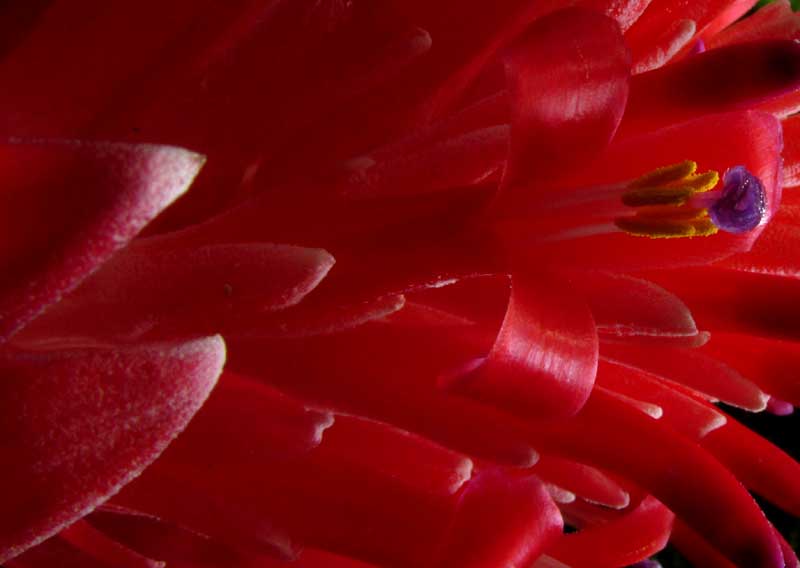Excerpts from Jim Conrad's
Naturalist Newsletter
from the August 16, 2018 Newsletter issued from Rancho Regenesis in the woods ±4kms west of Ek Balam Ruins, central Yucatán, MÉXICO
FLAMING TORCH BROMELIAD
At Genesis Resort, operated by the owner of the rancho on which I live, and from which I issue these Newsletters, pathways between rooms pass through a very pretty tropical garden. Nowadays some knee-high, ground-growing bromeliads are spectacularly flowering there, one of which is shown below:

There you're seeing a raceme-type flowering head, or inflorescence, arising from a rosette of stiff, tough, slender blades with margins bearing widely spaced, low, thick-based spines. A close-up of a flower in that inflorescence is shown below:

To distinguish the red flower from the may red bracts around it, locate the purple sphere at the image's right. That's the stigma, where pollen grains are supposed to land. It's affixed atop a slender filament that leads to the unseen ovary at the corolla's bottom. Just left of the stigma, the yellowish, banana-shaped items are pollen-producing anthers, borne atop slender, pale filaments. The tuft of filaments arises from a shadowy zone surrounded by backward-curving petals. The red, non-corolla parts are bracts, which are modified leaves, in this case serving with their bright color to attract pollinators to the flowers.
One special feature of this species is that its red sepals and corollas acquire a violet hue toward their tips, plus much of the inflorescence is sparsely covered with minute white scales which in some parts produce a silvery effect. In the above photo the bract tips at the image's left display such silveriness.
Because of its general form and flower structure, it was clear from the first that these plants were members of the tropical American Bromelia or Pineapple Family, the Bromeliaceae. Of the over 1300 species in that family, most live on tree branches (epiphytic), the Pineapple plant being an exception.
Our plant is BILLBERGIA PYRAMIDALIS, commonly known as Flaming Torch. It's native to northern South America and the Caribbean area. I read that in Florida it's probably the most planted bromeliad not only because it's pretty but also because it's tough, adaptable, and easy to propagate -- as long as it doesn't get cold. Ours is living very well on the ground, but I read that if individuals are perched on a tree limb they'll thrive there, too, and if planted at a tree's base, its plentiful offshoot-plants will slowly populate the trunk.
Like most bromeliads, Flaming Torches are "monocarpic," meaning that once the plant fruits, it dies, though normally sprouts are left behind to take its place.